 Abraham Lincoln
If given the truth, the people can be depended upon to meet any national crisis...
Abraham Lincoln
If given the truth, the people can be depended upon to meet any national crisis...
 Guildford news...
for Guildford people, brought to you by Guildford reporters - Guildford's own news service
Guildford news...
for Guildford people, brought to you by Guildford reporters - Guildford's own news service
Looking Back At Guildford Rotarians’ Service And Fundraising As They Celebrate Their Centenary
Published on: 7 May, 2022
Updated on: 7 May, 2022
Members of the Rotary Club of Guildford are celebrating the club’s 100th anniversary and have been charting its history from its beginnings to the present day. Based on an anniversary brochure the club has produced, here are some of the key moments in the history and fundraising activities of Guildford’s three rotary clubs.
It was on July 14, 1921, that 10 Guildford businessmen passed a resolution to form a Rotary club, which was the 50th club in Great Britain and the first in Surrey.

Albert Hickling. All pictures from the Rotary Club of Guildford’s 100th anniversary brochure.
The initiative was led by Albert Hickling, the manager of the local branch of a firm of cattle feed manufacturers J. Bibby & Sons. The club was formed with 21 members, who paid an annual subscription of one guinea to attend meetings.
The club’s first meeting took place at Pitchers Café on October 3, and by then the membership had risen to 33. The use of the term “Mr”, when addressing a fellow member was banned, on the penalty of a fine of one penny.
In 1923 the club launched its ‘Big Brother scheme’, aimed to benefit the 50 or so Guildford youngsters who had lost their fathers during the First World War.
The club’s history reveals that these youngsters were “adopted by members of the club and steered along the path towards good citizenship and worthwhile careers”.
In the 1920s the club also made substantial donations to the Guildford & District Nursing Association, the Institute for the Blind, the railwayman’s orphanage and many other local charities.
In 1927 it started a scheme to raise enough money to install several of the new-fangled wireless sets at the Royal Surrey County Hospital.
In 1925, the club’s Ladies Auxiliary was formed as a separate club, later to become the Guildford Inner Wheel Club.
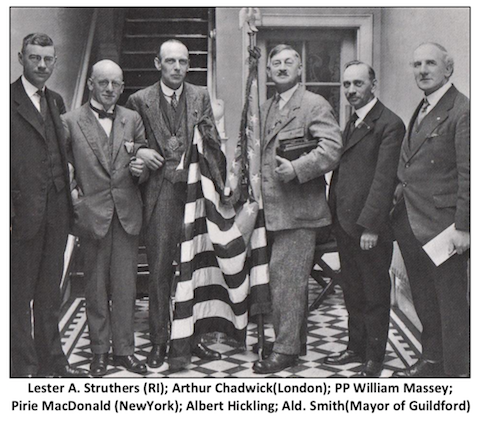
The occasion in 1924, when a stars and stripes flag was presented on behalf of the Rotary Club of New York by Rotarian Pirie MacDonald.
The club had acquired most of its insignia by the mid 1920s, but one notable addition was added in 1924, when a stars and stripes flag was presented on behalf of the Rotary Club of New York by Rotarian Pirie MacDonald.
After the club’s American visitor had presented the flag, he was presented in turn with a George III tea caddy and some gold cuff links as a reminder of the day he visited Guildford.
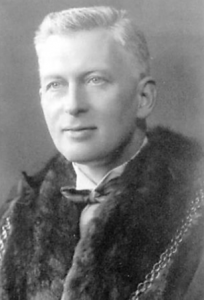
William Harvey.
During the depression and high unemployment of the 1930s, Rotarian and Mayor of Guildford, William Harvey, set up a work fund scheme in which residents were asked to contribute a set sum of money each week to keep 600 men in regular work. The building of Guildford Lido was once such project men worked on.
Behind the work fund scheme was the Guildford Council of Social Service, on which the Rotary Club of Guildford was represented, working closely with the council, the labour exchange and public assistance officers.
On the home front during the Second World War, the club was busy. Most memorable was club members dealing with the reception of evacuated troops from Dunkirk, when their trains paused while passing through Guildford railway station between May 27 and June 4 1940.
Volunteers from the Rotary Club of Guildford were joined by members of Toc H, Crusaders, the Women’s Voluntary Service, Round Table and the Salvation Army, handing out provisions to the war-weary service personnel.
In May 1941, the club adopted a ‘flower class’ corvette HMS Petunia. The initial gift to its crew was three pairs of binoculars, sports gear plus an annual subscription to Punch magazine and other periodicals.
In 1948, the need for a rest room for elderly people was realised with the opening of one at the Guildford Institute. Members of Rotary, Inner Wheel and Round Table worked together to run and furnish the room and the Rotary club gave £50 from its ‘Lame Dog Fund’ together with £150 raised at a jumble sale towards the rest room.
At the start of the 1950s, the club organised a mobile Christmas tree, which toured the town centre and collections were taken for the Mayor’s Christmas Fund. But with bad weather and other adverse circumstances, the results were often disappointing.
Therefore, in 1951 it was decided to hold a carol concert at Guildford Methodist Church instead. This idea was developed further and Rotarian Jack Clitheroe, the town’s municipal director of music, undertook the arrangement of the programme and brought his festival choir to lead the singing.
The carol concert soon became a very popular town event, filling the church and increasing contributions to the mayor’s fund considerably.
The Mayor of Guildford’s Christmas Concert has become one of the town’s highlights of the festive season and now takes place in Holy Trinity Church with music provided by the Vivace Chorus.
Rotarian Frank Sparrow (later a Guildford mayor and alderman) in 1958 proposed the club should organise a competition for local schools aimed at building pupils’ confidence when speaking in public.
It laid the foundations for the Youth Speaks Competition, which continues to this day, and allows young people from Guildford schools to compete against each other and develop many life skills.
Guildford’s Repertory Theatre in North Street had close ties with the club over many years, with its manager Patrick Henderson as one of its members.
Other Rotarians had served on the theatre’s board at one time or another, including former Mayor Archie Graham-Brown and Jack Penycate, editor of the Surrey Advertiser.
Planning for the Yvonne Arnaud Theatre was expedited by the disastrous fire that engulfed the old Repertory Theatre in 1963, and Rotarian John Brownrigg was appointed as the new theatre’s architect, along with Archie Graham Brown as chairman of the theatre’s appeal trust.

Help for disabled people to enjoy Christmas shopping in Guildford.
In November 1968, the club’s Guildford’s Community Services Committee decided that it should organise services for disabled people, particularly those confined to wheelchairs, to enable them to shop in comfort at Christmas time.
The idea was eagerly received by the management and staff of Guildford’s branch of Marks & Spencer, who in turn obtained the co-operation of Woolworths. These stores remained open for an additional two hours on a Tuesday evening just before Christmas solely for the use of disabled people.
The attendance on the first year was 281, by 1983 had risen to 1,000. By 1991, Boots and WH Smith had joined the disabled shopping evening, with all the shops staffed entirely by volunteers.
In 1975, discussions started about forming a second Rotary club in Guildford, and this would become the first time a second club in any town was permitted by Rotary International.
The charter night of the Rotary Club of Guildford District was held at Harvey’s Restaurant (now part of Guildford’s House of Fraser store)) on November 5, 1975.
In March 1978, the district club held its first charity boxing night, which turned out to be the club’s main fundraiser for 40 years. The best year was 2005 when more than £38,000 was raised in one night, until the last event in 2017 when a total £750,000 had been raised – an amazing amount that went to so many local and international good causes.
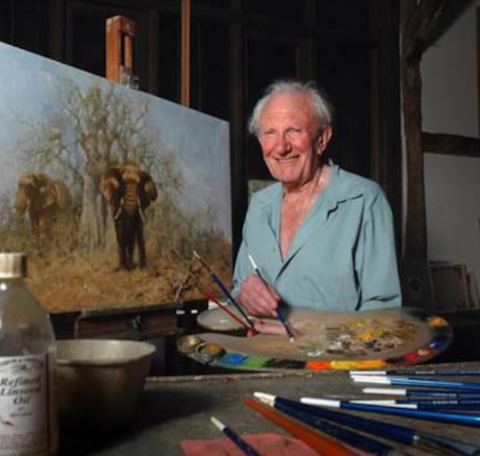
Artist David Shepherd.
One of the major supporters of the event over the years was the artist David Shepherd, who donated an original painting for auction each year.
The district club continues to run its sponsored walk in May each year. Initially suggested by the Surrey Advertiser, over the years it has helped raise more £1 million for other charities and organisations’ good causes.
To commemorate the 50th anniversary of the Rotary Club of Guildford in 1972, the club wrote to the Dean of Guildford Cathedral offering to provide a treble bell, bringing the number of bells in its tower to a complete ‘ring’ of 12.

The bell at Guildford Cathedral donated by the Rotary Club of Guildford.
The new bell was incised with the Rotary wheel on its rim with an appropriate inscription to record the event.
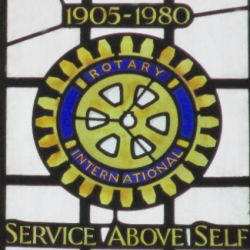
The Rotary stained glass window in Guildford Cathedral
The Rotary stained glass window in Guildford Cathedral was dedicated on Sunday, February 17, 1980 at a service attended by a congregation of Rotarians from all over the Diocese of Guildford.
The window was given on behalf of District 114 and was the result of an initiative by the Rotary Clubs of Leatherhead, Bookham & Horsley, to commemorate the 75th anniversary of the founding of Rotary.
Since 1987, the Rotary movement and its members have been committed to the fight to eradicate polio across the world.

Purple 4 Polio.
The board of directors of Rotary International and the trustees of the Rotary Foundation agreed to undertake, with public support, to raise the substantial sum of $120,000,000 to fund their Polioplus programme.
The Rotary Club of Guildford’s president, Ray Jackson, made it his personal commitment to raise £1,750 during his year of office through a series of fund-raising events.
In conjunction with the district club, it was also decided to approach local companies and businesses for their help in supporting this massive exercise to help immunise the children of the world against this deadly disease.
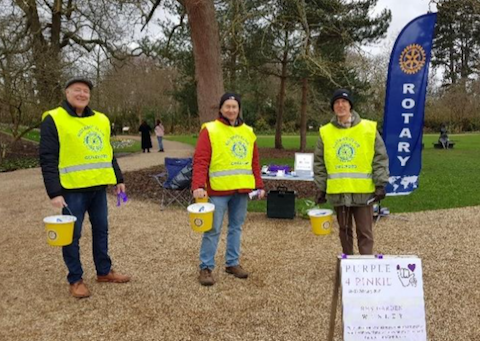
Rotarian collecting funds at the the RHS Garden Wisley.
Thirty-five years later the battle against Polio still continues under the banner of Purple 4 Polio and the Rotary Club of Guildford holds regular collections each year at the RHS Garden Wisley.
At the beginning of the decade, the club undertook to raise £10,000 towards establishing a school of nursing at the Royal Surrey County Hospital.
The Ted Adams Trust was established for the benefit of nurses and midwives in the Guildford area and provides accommodation for student nurses in Ted Adams House and also grants to further the professional development of qualified nurses and midwives. Ted Adams was editor of the Surrey Advertiser at the time.

Jaipur Limb Project has helped countless people.
In 1985, Dr Clive Addis-Jones helped set up the Jaipur Limb Project, during his term as president of the club and was the founder chairman when it became a registered charity in 1993.
The project has not only support the work in Jaipur but it has been expanded into the establishment of permanent limb centres and temporary limb camps throughout India, Africa and in Haiti, following the earthquake there in 2010.
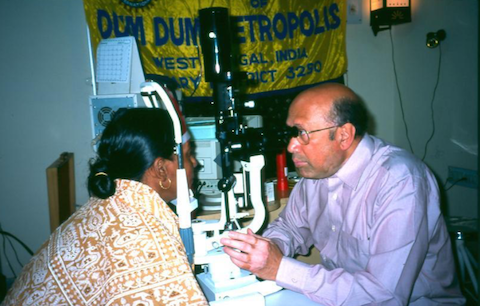
Sam Das founded the Guildford Eye Project.
The club’s Guildford Eye Project was founded in 1998 by senior eye consultant at the Royal Surrey County Hospital, Sam Das, also a Rotarian.
His personal ambition was to provide free cataract surgery to one million of the world’s poor and needy. To bring this about, Sam initiated and implemented a four-fold strategy involving Rotary clubs in the UK and the Rotary Foundation to eradicate avoidable blindness, initially in Kolkata and then spreading the programme to other parts of India.
The final decade of the 20th century saw a third Rotary club established in Guildford.
The Rotary Club of Guildford Chantries was given its charter in 1991 with the purpose of creating an evening club for businessmen, who would normally be unable to attend Rotary functions during the day.
When giant waves from the devastating Tsunami battered South East Asia on Boxing Day 2004, Rotarians from around the globe responded with an outpouring of money and support for the victims of the disaster.
Rotary International declared Saturday, January 8, 2005 as Tsunami Collection Day and in Guildford, all three Rotary clubs were out in the town centre with their collecting tins. By the end of the day, the combined efforts of Guildford Rotarians had collected £4,725.
In February 2010, the Rotary Club of Guildford celebrated Rotary week by completing a project to help people in Guildford who suffer with Multiple Sclerosis.
Three pieces of equipment were purchased for Guildford’s Multiple Sclerosis Centre to give sufferers advanced physiotherapy, rehabilitation and help with their mobilisation.
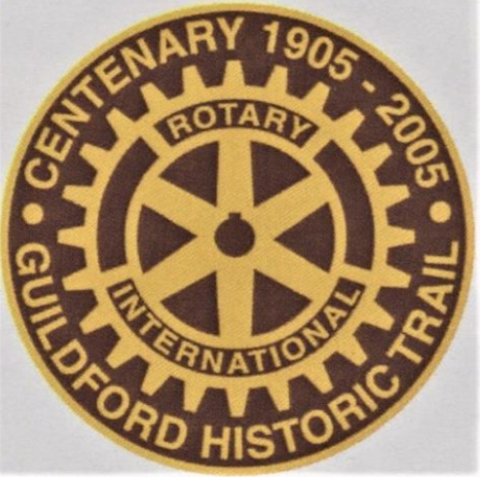
Roundels in the pavement mark a historic trail around Guildford town centre.
In 2003, Guildford’s three Rotary clubs started to ponder about a joint project to celebrate 100 years of Rotary International in 2005 and came up with the novel suggestion of establishing an historic trail around the town centre, where a route is marked with roundels in the pavement.
The project was led and organised by Roger Hull from the Chantries club, with help from Geoff Rouse, Don Raffin and president Norman Newton from the district club.
The president of the Rotary Club of Guildford, Frank West, used his business contacts in China to get the 33 metal roundels manufactured for the pavements.
On April 30, 2022, Guildford’s three Rotary clubs were presented with the Mayor of Guildford’s Award for Service to the Community, in recognition of their exceptional work in the community.
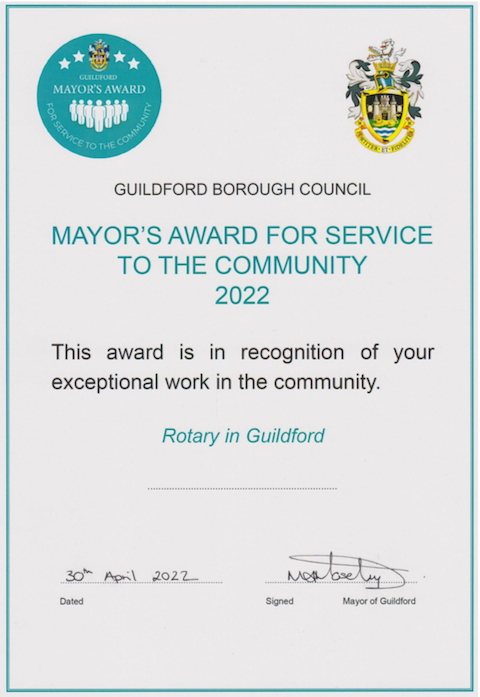
The Mayor of Guildford’s Award for Service to the Community to Guildford’s three Rotary clubs. Rotary’s motto is ‘service above self’.
Recent Articles
- Guildford Institute’s Crowdfunding Project for Accessible Toilet in its New Community and Wellbeing Centre
- Letter: Guildford – Another Opportunity Missed?
- Letter: GBC’s Corporate Strategy – Where Is the Ambition?
- My Memories of John Mayall at a Ground-breaking Gig in Guildford Nearly Six Decades Ago
- Westborough HMO Plans ‘Losing the Heart of the Street’ Says Resident
- College Invests to Boost Surrey’s Economy and Close Digital Skills Gap
- Community Lottery Brings Big Wins for Local Charities
- GBC Housing Plan Promises ‘A Vibrant Urban Neighbourhood’ Near Town Centre
- Hospital Pillows ‘Shortage’ at the Royal Surrey
- Updated: Caravans Set Up Camp at Ash Manor School


Search in Site
Media Gallery
Dragon Interview: Local Artist Leaves Her Mark At One of England’s Most Historic Buildings
January 21, 2023 / No Comment / Read MoreDragon Interview: Lib Dem Planning Chair: ‘Current Policy Doesn’t Work for Local People’
January 19, 2023 / No Comment / Read MoreA3 Tunnel in Guildford ‘Necessary’ for New Homes, Says Guildford’s MP
January 10, 2023 / No Comment / Read More‘Madness’ for London Road Scheme to Go Ahead Against ‘Huge Opposition’, Says SCC Leader
January 6, 2023 / No Comment / Read MoreCouncillor’s Son Starts Campaign for More Consultation on North Street Plan
December 30, 2022 / No Comment / Read MoreCounty Council Climbs Down Over London Road Works – Further ‘Engagement’ Period Announced
December 14, 2022 / No Comment / Read MoreDragon Interview: GBC Reaction to the Government’s Expected Decision to Relax Housing Targets
December 7, 2022 / No Comment / Read MoreHow Can Our Town Centre Businesses Recover? Watch the Shop Front Debate
May 18, 2020 / No Comment / Read More









Recent Comments